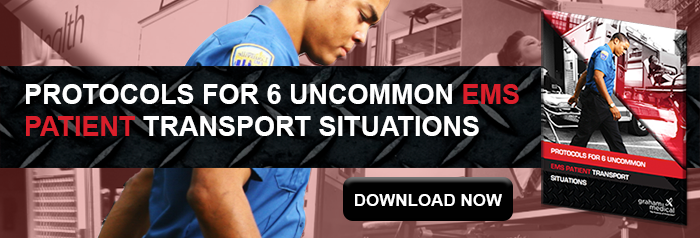 As EMS providers, there are two clear categories of importance for patient transportation: protecting the patient and protecting EMS personnel. Administrators carry the responsibility of implementing safe practices to manage this transportation effectively by using knowledge of injury management to conduct training, and providing the tools and equipment needed to carry out these procedures.
As EMS providers, there are two clear categories of importance for patient transportation: protecting the patient and protecting EMS personnel. Administrators carry the responsibility of implementing safe practices to manage this transportation effectively by using knowledge of injury management to conduct training, and providing the tools and equipment needed to carry out these procedures.
By having specific protocols for different forms of injury transport, administrators can help ensure the best outcomes. Guidelines for the safe transport of musculoskeletal injuries include:
Musculoskeletal Injury Categorization
Musculoskeletal injuries are rated by severity and urgency according to Academic Emergency Medicine. Some of these injuries may be able to be treated by EMS on site, but more severe injury indications require careful transport to a local medical facility.
- Category One - amputations, femur fractures, multiple trauma presences, neurovascular compromise, severe pain, open fractures, and hip fracture or dislocation
- Category Two - avulsion of digit tips and isolated extremity injury
- Category Three - injury with no loss of function, points of tenderness, and/or swelling, need for tetanus prophylaxis
- Category Four - contusions and abrasions
Detailed protocols explain the priority of care for musculoskeletal injuries as well as 2017 specific EMS guidelines for checking distal pulses and treating amputations. EMS personnel must focus on wound care and stabilization of affected areas. If this treatment requires transport to a hospital or emergency facility, the protocol must emphasize stability and support to prevent further injury and discomfort.
EMS Transport Procedure
While EMS workers are experts when it comes to patient care, they are not as conscientious when it comes to caring for themselves. Trying to safely and comfortably ease a patient into transport vehicles many subject staff to painful injury in this process.
The CDC reports that 35% of EMS injuries are from overexertion, with almost a third resulting in a sprain or strain. These injuries can often be prevented by using ergonomic lifting techniques and modern medical equipment. Gone are the days of dead-lifting stretchers to load position, or using a sheet to drag a patient from bed to gurney.
Modern EMS need equipment that supports both medical provider and patient, such as flexible gurneys and adjustable height stretchers. Discover the latest innovations in patient transport care with the experts at Graham Medical. The knowledgeable staff can help you maximize cost-reduction, quality of care, and safety for patients and personnel.

